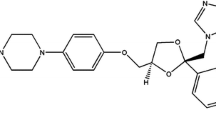Abstract
In order to develop a novel transdermal drug delivery system that facilitates the skin permeation of finasteride encapsulated in novel lipid-based vesicular carriers (ethosomes)finasteride ethosomes were constructed and the morphological characteristics were studied by transmission electron microscopy. The particle size, zeta potential and the entrapment capacity of ethosome were also determined. In contrast to liposomes ethosomes were of more condensed vesicular structure and they were found to be oppositely charged. Ethosomes were found to be more efficient delivery carriers with high encapsulation capacities. In vitro percutaneous permeation experiments demonstrated that the permeation of finasteride through human cadaver skin was significantly increased when ethosomes were used. The finasteride transdermal fluxes from ethosomes containing formulation (1.34 ± 0.11 μg/cm2/h) were 7.4, 3.2 and 2.6 times higher than that of finasteride from aqueous solution, conventional liposomes and hydroethanolic solution respectively (P < 0.01).Furthermore, ethosomes produced a significant (P < 0.01) finasteride accumulation in the skin, especially in deeper layers, for instance in dermis it reached to 18.2 ± 1.8 μg/cm2. In contrast, the accumulation of finasteride in the dermis was only 2.8 ± 1.3 μg/cm2 with liposome formulation. The study demonstrated that ethosomes are promising vesicular carriers for enhancing percutaneous absorption of finasteride.






Similar content being viewed by others
References
J. Hadgraft, M. Whitefield, and R. H. Rosher. Skin Penetration of Topical Formulations of Ibuprofen 5%: An in vitro Comparative Study. Skin Pharmacol Appl Skin Physiol. 16:137–142 (2003).
M. R. Prausnitz, S. Mitragotri, and R. Langer. Current status and future potential of transdermal drug delivery. Nat Rev Drug Discov. 3:115–124 (2004).
Q. H. Hu, W. Q. Liang, J. L. Bao, and Q. N. Ping. Enhanced transdermal delivery of tetracaine by electroporation. Int J Pharm. 202:121–124 (2000).
J. A. Bouwstra, P. L. Honeywell-Nguyen, G. S. Gooris, and M. Ponec. Structure of the skin barrier and its modulation by vesicular formulations. Prog Lipid Res. 42:1–36 (2003).
E. Touitou. Compositions for applying active substances to or through the skin. US patent 1996; 5,540,934.
E. Touitou, M. Alkabes, N. Dayan, and M. Eliaz. Ethosomes: novel vesicular carriers for enhanced skin delivery. Pharm Res. 14:S305 (1997).
B. W. Barry. Novel mechanisms and devices to enable successful transdermal drug delivery. Euro J Pharm Sci. 14:101–114 (2001).
B. Godin, and E. Touitou. Ethosomes: New Prospects in Transdermal Delivery. Crit Rev Ther Drug. 20:63–102 (2003).
E. Touitou, B. Godin, and C. Weiss. Enhanced delivery of drugs into and across the skin by ethosomal carriers. Drug Dev Res. 50:406–415 (2000).
G. J. Gormley. Finasteride: a clinical review. Biomed & Pharmacother. 49:319–324 (1995).
O. Gornelia, and W. A. Heidi. Partition behaviour of acids and base in a phosphatidylcholine liposome—buffer equilibrium dialysis system. Euro J Pharm Sci. 4:223–231 (1997).
J. Yamahara, H. Kashiwa, K. Kishi, and H. Fujimura. Dermal penetration enhancement by crude drugs: in vitro skin permeation of prednisolone enhanced by active constituents in cardamon seed. Chem Pharm Bull. 37:855–856 (1989).
F. Yamashita, and M. Hashida. Mechanistic and empirical modeling of skin permeation of drugs. Adv Drug Deliv Rev. 55:1185–1199 (2003).
K. Sato, N. Mitsui, T. Haseqawa, K. Suqibayashi, and Y. Morimoto. Potential usefulness of solubility index for prediction of the skin permeation rate of 5-ISMN from pressure-sensitive adhesive tape. J Control Release. 73:269–277 (2001).
N. Dayan, and E. Touitou. Carriers for skin delivery of trihexyphenidyl HCl: ethosomes vs. liposomes. Biomaterials. 21:1879–1885 (2000).
M. Meize, and V. Gulasekharam. Liposomes—a selective drug delivery system for the topical route of administration. Life Sci. 26:1473–1477 (1980).
M. Kirjavainen, A. Urtti, R. Valjakka-Koskela, J. Keisvaara, and J. Monkkonen. Liposome—skin interactions and their effects on the skin permeation of drugs. Eur J Pharm Sci. 7:279–286 (1999).
M. Schaller, and H. C. Korting. Interaction of liposomes with human skin: the role of the stratum corneum. Adv Drug Del Rev. 18:303–309 (1996).
G. Cevec. Lipid vesicles and other colloids as drug carriers on the skin. Adv Drug Del Rev. 56:675–711 (2004).
E. Touitou, D. Dayan, L. Bergelson, B. Godin, and M. Eliaz. Ethosomes—novel vesicular carriers for enhanced skin delivery: characterization and skin penetration properties. J Control Release. 65:403–418 (2000).
A. K. Kohli, and H. O. Alpar. Potential use of nanoparticles for transcutaneous vaccine delivery: effect of particle size and charge. Int J Pharm. 275:13–17 (2004).
G. Cevc, and G. Blume. New, highly efficient formulation of diclofenac for the topical, transdermal administration in ultradeformable drug carriers, Transfersomes. Biochim Biophys Acta. 1514:191–205 (2001).
H. S. Gwak, and I. K. Chun. Effect of vehicles and penetration enhancers on the in vitro percutaneous absorption of tenoxicam through hairless mouse skin. Int J Pharm. 236:57–64 (2002).
V. Dubey, D. Mishra, M. Nahar, and N. K. Jain. Vesicles as tools for the modulation of skin permeability. Expert Opin Drug Deliv. 4:579–93 (2007).
Acknowledgement
We would like to thank the Anatomy Department of Medicine School, ZheJiang University, for providing the human cadaver skin. We are also grateful to Ms. Xu for her technical support for TEM visualization.
Author information
Authors and Affiliations
Corresponding author
Rights and permissions
About this article
Cite this article
Rao, Y., Zheng, F., Zhang, X. et al. In Vitro Percutaneous Permeation and Skin Accumulation of Finasteride Using Vesicular Ethosomal Carriers. AAPS PharmSciTech 9, 860–865 (2008). https://doi.org/10.1208/s12249-008-9124-y
Received:
Accepted:
Published:
Issue Date:
DOI: https://doi.org/10.1208/s12249-008-9124-y




